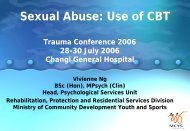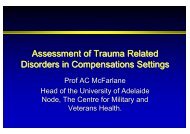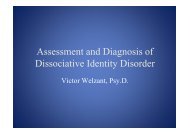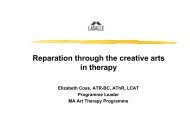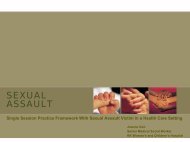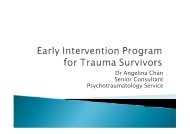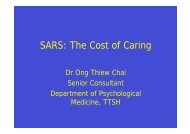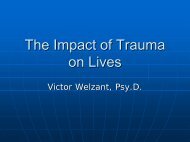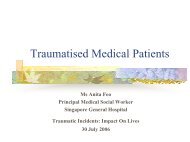(A) Medical Report Writing by Prof Alexander McFarlane - Trauma ...
(A) Medical Report Writing by Prof Alexander McFarlane - Trauma ...
(A) Medical Report Writing by Prof Alexander McFarlane - Trauma ...
You also want an ePaper? Increase the reach of your titles
YUMPU automatically turns print PDFs into web optimized ePapers that Google loves.
PTSD: The Concept and Challenges<br />
in the Medico legal settings<br />
<strong>Prof</strong> A.C.<strong>McFarlane</strong><br />
Head, Centre of Military and Veterans<br />
Health<br />
The University of Adelaide.
1983 Ash Wednesday Bushfires<br />
<br />
<br />
<br />
<br />
<br />
<br />
<br />
808 Primary school children<br />
2600 registered disaster victims<br />
459 CFS firefighters<br />
320 patients<br />
Interviewed the departmental relief co-coordinators<br />
coordinators<br />
Surveyed disaster relief teams<br />
Post disaster litigation
<strong>Trauma</strong>tic Events<br />
Melbourne/Voyager 82 men killed 1964<br />
Ash Wednesday Bushfire Disaster<br />
Yunnan Earthquake in China - 800 deaths<br />
Iraqi invasion of Kuwait 1993-2003<br />
Kobe Earthquake 30,000 deaths<br />
Bali Bombing 82 deaths<br />
Port Arthur Massacre in Tasmania - most killings <strong>by</strong> a single gunman<br />
Australian Defence Force<br />
Mine accident, roof collapse in golf club, school bus accident, shooting<br />
of doctor, murder of director of mental health services, ship wrecks,<br />
collapse of amusement ride into crowd, seige with gunman, railway<br />
accident
Musée e des Beaux Arts W.H.<br />
Auden ( 1938 )<br />
About suffering they were never wrong,<br />
the Old Masters: how well they<br />
Understood Its human position; how it<br />
takes place while someone else Is<br />
eating or opening a window or just<br />
walking dully along
The Ash Wednesday Fires, February 16 1983
Ash Wednesday Disaster<br />
75 people killed<br />
2676 injured<br />
Over 3700 buildings destroyed<br />
1,032,000 acres burnt
1983 Ash Wednesday Bushfires<br />
<br />
<br />
<br />
<br />
<br />
<br />
<br />
808 Primary school children<br />
2600 registered disaster victims<br />
459 CFS firefighters<br />
320 patients<br />
Interviewed the departmental relief co-coordinators<br />
coordinators<br />
Surveyed disaster relief teams<br />
Post disaster litigation
Black Saturday<br />
7 th February 2009
Similarity of Weather Systems<br />
Ash Wednesday<br />
Black Saturday
Black Saturday<br />
48 hours before the Premier highlighted<br />
the extraordinary fire risk<br />
Headline on day of the disaster-before<br />
the fires- “Worst day in History”<br />
173 People killed<br />
2,600 buildings destroyed<br />
Area 1.1 million acres – Japan is 93 mil<br />
Injured 600 +
Newmatilda.com<br />
The story of the CFA’s s bumbling, chaotic response<br />
to the Kilmore East fire is a tragic echo of the<br />
failures of emergency services and disaster<br />
response efforts in other countries. During 9/11 in<br />
New York and Hurricane Katrina in New Orleans,<br />
US authorities suffered the same sorts of<br />
breakdowns in communications and failures of<br />
command and control. Indeed, Rees’s s disengaged<br />
and bumbling performance on the day resembles<br />
most closely the performance of the notorious<br />
Michael Brown, the incompetent boss of the Federal<br />
Emergency Management Agency during Hurricane<br />
Katrina
Lessons Learnt<br />
Academic Study of mental health<br />
outcomes does not record critical issues<br />
for survival behaviour<br />
Warnings are not expressed in language<br />
or forms that change behaviour<br />
Journalists do not record or report<br />
critical facts<br />
Failure to learn from past lessons
Issues Emerging after Black<br />
Saturday<br />
Failure of people to grasp reality of<br />
messages<br />
Failure to predict fire behaviour despite<br />
previous knowledge<br />
Verbal information does not prepare<br />
people for reality<br />
Media did not grasp the reality
Uses and Abuses<br />
The role of the law of tort<br />
The impingement of social and political<br />
agendas on medicine
<strong>Trauma</strong>tic Stress: Emotional or<br />
Organic?<br />
“Railroad spine” - Erichsen saw an organic cause (1866)<br />
Page (1885) suggested psychological origins<br />
“many errors in diagnosis have been made because<br />
fright has not been considered of itself sufficient”<br />
Oppenheim(1889) - coined term traumatic neurosis<br />
Functional problems are produced <strong>by</strong> subtle molecular<br />
changes in the CNS
Compensat ion Law<br />
Patient Clinician Science Society<br />
Models of<br />
Psychopatho logy<br />
Experimental<br />
Paradigms
Patient Clinician Science Society
Uses and Abuses<br />
The struggle between the individual and<br />
government<br />
The battle between corporations and<br />
workers<br />
An individual’s s beliefs are at the<br />
foundation of political ideology
….the<br />
‘potential explosive impact’ of<br />
stress related diagnoses on ‘societal<br />
approaches to responsibility and<br />
accountability. xxii<br />
Ben Shephard. War of Nerves. 2000
Death of Private Kovco<br />
NSW coronial hearing<br />
Gun shot wound to the head<br />
In the presence of 2 other soldiers<br />
Had been joking with each other in the<br />
minutes before<br />
Individual who applied first aid<br />
misidentified the body
Context and meaning<br />
Affect and fear<br />
Dorsolateral<br />
Prefrontal cortex<br />
Medial<br />
Prefrontal cortex<br />
Hippocampus<br />
amygdala
Facial Affect Recognition<br />
Critical capacity of arousal to switch<br />
information processing systems<br />
Need to define context as well as<br />
emotion<br />
Central vehicle of attachment skills and<br />
affect regulation
Childhood Sexual Abuse<br />
Recall of previous abuse forgotten.<br />
Is this possible?
Time 1 Time 2<br />
Event<br />
Event<br />
Symptoms<br />
Symptoms
T ab le 1 : Reco llect ion of Bu shfire Expo sur e a t 20 Ye ar Follo w -up<br />
Acc ura te O vere st im ater U nd ere stim ater No Reco llec ti on<br />
Reca ll<br />
N (%) N (%) N (% ) N (%)<br />
m ily M em ber<br />
ure d/Ki lle d<br />
he r 277 (92 % ) 16 (5 .3% ) 2 (0 .7% ) 6 (2 % )<br />
ther 293 (97 % ) 4 (1 .3% ) 3 (1 % ) 2 (0 .7% )<br />
ling s 299 (99 % ) 0 0 3 (1 % )<br />
andpa ren ts 294 (97 .4% ) 1 (0 .3% ) 3 (1 % ) 4 (1 .3% )<br />
he r R elatives 274 (90 .7% ) 10 (3 .3% ) 6 (0 .7% ) 12 (1 .5% )<br />
ends In jured/Kill ed<br />
en t’s Fri ends 198 (65 .6% ) 46 (15 .2% ) 21 (7 % ) 37 (12 .3% )<br />
ends 261 (86 .4% ) 19 (6 .3% ) 5 (1 .7% ) 17 (5 .6% )<br />
m age /De str ucti on to<br />
oper ty<br />
use 266 (88 .1% ) 27 (8 .9% ) 8 (2 .6% ) 1 (0 .3% )<br />
nt & Farm Ma chin ery 229 (75 .8% ) 59 (19 .5% ) 4 (1 .3% ) 10 (3 .3% )<br />
279 (92 .4% ) 12 (4 % ) 3 (1 % ) 8 (2 .6% )<br />
eds 250 (82 .8% ) 36 (11 .9% ) 5 (1 .7% ) 11 (3 .6% )<br />
perty fo r M ak ing Inco m e 215 (71 .2% ) 56 (18 .5% ) 18 (6 % ) 13 (4 .3% )<br />
ur ies to Stock 252 (83 .4% ) 33 (10 .9% ) 5 (1 .7% ) 12 (4 % )<br />
ur ies to Pet s 259 (85 .8% ) 25 (8 .3% ) 8 (2 .6% ) 10 (3 .3% )<br />
T ot al N=302<br />
Bu shf ir e Su rvivo rs
Impact of current disorder on Recall<br />
No recall 37.5% had a current disorder<br />
disorder v’sv<br />
s 13% of controls (p=0.005)<br />
No recall 25% had a current depression<br />
disorder v’sv<br />
s 3% of controls (p
The Role of an Expert Witness
Experience as an expert witness<br />
Hard to predict how experience will prepare<br />
Always be consistent<br />
Ultimate test of knowledge and<br />
accountability<br />
Public critique<br />
Conflict with colleagues<br />
Important that psychiatric and psychological<br />
knowledge impacts in the public domain
What is an expert?<br />
Provide knowledge that can not be<br />
presumed from the average citizen<br />
Standards of expert evidence<br />
determined <strong>by</strong> professions<br />
Challenge of the self appointed expert<br />
witness –risks of overconfidence<br />
Duty to inform the court and not be an<br />
advocate
Guidelines of American College<br />
Qualifications<br />
of Physicians<br />
» Current licence<br />
» Recognized qualification in the specialty or<br />
subspecialty<br />
» Familiar with and involved in the area of<br />
practice in 3 of last 5 years
Guidelines of the American<br />
College of Physicians<br />
Testify with honesty, fully and impartially as to<br />
qualifications<br />
Impartiality about the information in the case<br />
Review prevailing standards of practice at the<br />
time<br />
Qualify whether an opinion is based on<br />
personal experience, specific clinical<br />
experience or generally accepted opinion
Guidelines of the American<br />
College of Physicians<br />
Compensation is reasonable and<br />
commensurate with time and effort<br />
Unethical to base fees on the outcome<br />
of the case<br />
Be aware that the evidence and<br />
depositions are on the public record and<br />
subject to peer review
Expert Role<br />
Answer questions with reasonable<br />
accuracy<br />
Help the court to reach a more accurate<br />
conclusion than would be possible<br />
Reliability and validity of clinical<br />
judgment<br />
Challenge of empathy versus objectivity<br />
Patients subjectivity versus reality
Factors limiting clinical judgement<br />
Limits of classification systems and<br />
knowledge generally<br />
Tendency to over weight supporting<br />
evidence and under weight negative<br />
facts<br />
Risks of overconfidence<br />
» Dealing with criticism of colleagues<br />
» Dealing with negative outcomes
EXPERT OPINION<br />
‣ Claims of expertise must stand test of scrutiny<br />
‣ Issue of expertise is answered in each case<br />
‣ Expert opinions must be within domain of expertise<br />
‣ Claim of expertise should be presented within<br />
context of each specific case
Daubert versus Merrell Dow<br />
Validity of expert testimony<br />
‣ Is the proposition or technique testable?<br />
‣ Has it been put to the test?<br />
‣ Has the proposition been subject to peer<br />
review?<br />
‣ Is there a known error rate?<br />
‣ Are there standards for using the<br />
methodology in place and been tested?<br />
‣ Is the technique generally accepted in the<br />
relevant scientific community?
Daubert restated in 2000<br />
The testimony based on sufficient facts<br />
and data<br />
The testimony is the product of reliable<br />
principles and methods<br />
The witness has applied the principles<br />
and methods reliably to the facts of the<br />
case
GOAL OF REPORT<br />
‣ Educate the reader/court<br />
‣ Provide your consultant with expert opinion<br />
‣ Separate facts from inferences<br />
‣ Answer required questions objectively<br />
‣ Translate technical information into user-friendly<br />
language<br />
‣ Do not be an advocate
REPORT PREPARATION<br />
‣ Only accept brief if you have time & resources<br />
‣ Establish your level of expertise<br />
‣ Familiarise yourself with pleadings/claim<br />
statements/etc<br />
‣ Insist on written letter of instruction<br />
‣ Learn what the major debate or theory of the case is<br />
AND its contrary view<br />
‣ Prepare adequate tests<br />
‣ Review appropriate material/literature
Ethics of Assessment/<strong>Report</strong> <strong>Writing</strong><br />
‣ Clarify your role<br />
‣ Inform client of purpose of report/assessment<br />
‣ Explain limits of confidentiality<br />
‣ If retained <strong>by</strong> council, we are representatives of the<br />
council and attorney-client privilege can apply (may<br />
need to seek advice)<br />
‣ Client has right to refuse assessment unless it<br />
court-mandated<br />
mandated…if client reluctant, do not push the<br />
issue before they discuss it with council
The different roles of an expert<br />
To provide a diagnosis and assess<br />
disability in personal injury matters<br />
To consider the role of causation in a<br />
personal injury case<br />
To provide an opinion about issues of<br />
negligence<br />
To provide evidence about the<br />
adequacy of treatment
Criminal Matters<br />
Does the individual have a psychiatric<br />
disorder that at the time of the crime?<br />
Does this provide some understanding<br />
the accused’s s behaviour?<br />
Is there a disorder or issues that the<br />
court should take into account at the<br />
time of sentencing?
Board’s s Enquiry<br />
Are there issues of human behaviour<br />
that assist in understanding the<br />
incident?<br />
Is a death suicide?<br />
Are there errors that we made and are<br />
these predictable?
Extension of time hearings<br />
How ought a plaintiff behave<br />
The issue of delayed onset disorders<br />
The difference between being ill and<br />
seeking treatment<br />
The issue of diagnostic practice and<br />
illness beliefs
Role with counsel<br />
To provide an opinion<br />
To assist in defining the points of liability<br />
and negligence – foreseeability<br />
To critique the opinion of colleagues<br />
To provide information that may assist in<br />
cross examination
Independent Witness?<br />
What is the role of the treating<br />
practitioner as an expert witness?<br />
The problem of dealing with the patient<br />
after writing a report<br />
The hired gun<br />
Codes of ethics and conduct directed <strong>by</strong><br />
the court
Bodies of Knowledge<br />
The ability to make a diagnosis<br />
» Impact on behaviour<br />
The literature about aetiology<br />
» Comes from many sources<br />
The history of that literature<br />
» Issues of liability<br />
The literature about treatment<br />
The prediction of prognosis and disability
You as an expert<br />
Do you have a special body of<br />
knowledge?<br />
When should you defer to a colleague?<br />
What are the boundaries of your<br />
knowledge?<br />
Do you have experience that<br />
differentiates you from your colleagues?<br />
How do you behave when questioned<br />
and criticized?
Diagnostic Assessments and <strong>Report</strong><br />
<strong>Writing</strong>
Format of the history<br />
The letter of instruction is critical<br />
Different jurisdictions have different<br />
questions<br />
Importance of explaining role to patient<br />
Explain the structure of the interview
How a medico legal history<br />
different from clinical practice<br />
Depends upon the questions being<br />
asked<br />
The timing of the onset of a disorder<br />
Need to properly apply diagnostic<br />
criteria<br />
Accurate assessment of comorbidities<br />
Record is meaningful to the court
Comments on reports<br />
Lack of exploration of phenomenology<br />
Need to separate cause from symptoms<br />
Stress is not a diagnosis<br />
Value of knowledge of diagnostic criteria<br />
Thresholds for symptoms<br />
Impact of treatment on symptoms<br />
Importance of medical comorbidities
Expressing opinion<br />
A history is not enough<br />
Need to summarize and synthesize<br />
Use ICD 10 or DSM IV criteria and<br />
discuss the points of uncertainty<br />
Address the issues of aetiology<br />
Disability assessment often determined<br />
<strong>by</strong> the jurisdiction
No one size fits all<br />
Deal with the specifics of the case<br />
Ensure that the facts of the case are tied to<br />
the questions asked<br />
To use inserts or not explaining particular<br />
issues of theoretical associations from the<br />
literature<br />
Acknowledge uncertainties and matters that<br />
require clarification
Language of report<br />
Do not be emotive<br />
Do not be prejudicial<br />
YOU ARE NOT AN ADVOCATE<br />
Define technical terms and concepts for<br />
the court<br />
Focus on the point<br />
Check facts against primary documents
Structure of report<br />
Source of referral<br />
<strong>Prof</strong>ile of Patient<br />
History of presenting illness<br />
Salient events related to presentation<br />
Systems review<br />
Past Psychiatric History including<br />
current treatment
Structure of reports<br />
Past medical history<br />
Medication<br />
Drug and alcohol history<br />
Family History<br />
Family Psychiatric History<br />
Family <strong>Medical</strong> History<br />
Premorbid personality
Personal history<br />
Structure of reports<br />
» Developmental psychosocial history<br />
» Educational history<br />
» Occupational history<br />
» Relationship history<br />
» Forensic history<br />
» Major life time traumatic events
Structure of reports<br />
Functional assessment<br />
Mental State Examination<br />
Diagnostic Tests<br />
Diagnosis and case formulation<br />
Documents provided and reviewed<br />
Addressing the assumptions as<br />
indicated <strong>by</strong> the solicitor<br />
Answer the questions posed
Fact versus Opinion
Facts<br />
Established in the history<br />
Describe the mental state and the quality of<br />
the history<br />
State the assumptions stated <strong>by</strong> the<br />
instructing solicitor<br />
Summarize the documents provided <strong>by</strong> the<br />
instructing solicitor<br />
State the limitations of the information
Opinion<br />
Opinion is what is required from an<br />
expert<br />
State when the issue is an opinion<br />
Diagnosis needs to be explained<br />
Critique documents and reports<br />
provided<br />
» What is their relevance to the matter at<br />
hand?
Opinion<br />
Summarize your views about the course<br />
of a disorder<br />
Summarize your views about aetiology<br />
and relate this to the history<br />
Highlight the points of agreement and<br />
disagreement between you and your<br />
colleagues<br />
Summarize the opinion at the end to<br />
restate the critical issues
The use of PTSD in forensic cases
M’Naugthen’ss Rules<br />
Attempted assassination of British Prime<br />
Minister Robert Peel in 1843<br />
Pistol shot to his secretary Edward<br />
Drummond who died 5 days later<br />
Not guilty <strong>by</strong> reason of insanity
M’Naugthen’ss Rules<br />
Every man is presumed to be sane<br />
Sufficient reason to be responsible for<br />
his crimes until proven to the contrary<br />
Accused was labouring under a defect<br />
of reason due to a disease of the mind<br />
Did not know the nature and quality of<br />
the act of what he was doing<br />
Or if he did know it, he did not know it,<br />
that he did not know it was wrong
Criminal Issues And PTSD<br />
<br />
<br />
<br />
Insanity defence<br />
– In USA 0.3% of felonies (0.93%)<br />
– 29% acquittal rate<br />
M’Naughten’ss Rules<br />
– Full blown flashback<br />
– Dissociative episode<br />
Undermined <strong>by</strong><br />
– evidence of concealment<br />
– Other rational behaviour
Diminished Capacity<br />
Factor impacting on mental state<br />
necessary for the commitment of the<br />
crime<br />
PTSD and diminished capacity<br />
Addiction to the trauma<br />
Need for punishment because of guilt<br />
Substance abuse to treat PTSD<br />
symptoms
Lack Of<br />
Consciousness/automatism<br />
Individuals who have committed<br />
sanctioned acts of violence<br />
Being awoken in a violent rage<br />
Excessive violence in self defence
Automatism<br />
Guilt requires the guilty act (actus(<br />
reus)<br />
and the guilty mind (mens(<br />
rea)<br />
The defense needs to prove that the<br />
defendant made only the physical<br />
movements and did not intend to commit<br />
the act must prove the mens rea.<br />
Liability is excused because the<br />
consequences of an act were not within<br />
the defendant’s s control
Self Defence<br />
Feminists and victims’ advocates see<br />
PTSD as more acceptable defence than<br />
insanity<br />
Special sensitivity to feeling threatened<br />
Experts role to explain the ongoing<br />
relationship with the abuser
Evidence Supporting PTSD as a<br />
Defence<br />
Unpremeditated behaviour<br />
uncharacteristic of the individual\<br />
Lack of coherent dialogue<br />
Choice of the victim is fortuitous or<br />
accidental<br />
Response is disproportionate to the<br />
provocation
Evidence Supporting PTSD as a<br />
Defence<br />
Defendant is unaware of the way that he<br />
is re-enacting enacting the traumatic experience<br />
Precipitants trigger the traumatic<br />
memory <strong>by</strong> symbolic or realistic<br />
similarities<br />
Amnesia for the episode
PTSD In Criminal Prosecution<br />
Mixed legal reception<br />
Used in determining damages<br />
Used as evidence where the defendant<br />
admits to intercourse but says<br />
consensual<br />
The defence can use it a method of<br />
cross examining about other aspects of<br />
the victim’s s life
McGee<br />
Prior PTSD<br />
Had a period of amnesia for 2 hours and<br />
then patchy amnesia<br />
Remembers the instant of the accident
Is this<br />
McGee and Amnesia<br />
» Retrograde (inability to remember<br />
memories prior to an event)<br />
» anterograde amnesia (inability to produce<br />
new memories after an event)?<br />
How does amnesia arise in the context<br />
of PTSD?<br />
Is purposeful behaviour possible when<br />
in an amnesic state?
Automatism<br />
Guilt requires the guilty act (actus(<br />
reus)<br />
and the guilty mind (mens(<br />
rea)<br />
The defense needs to prove that the<br />
defendant made only the physical<br />
movements and did not intend to commit<br />
the act must prove the mens rea.<br />
Liability is excused because the<br />
consequences of an act were not within<br />
the defendant’s s control
Mens Rea?<br />
Ability to behave in a purposeful manner<br />
Ability to ask for help<br />
Is this an all or none phenomena?
DSM IV definitions<br />
Dissociative amnesia (formerly Psychogenic<br />
Amnesia) - noticeable impairment of recall<br />
resulting from emotional trauma<br />
Dissociative fugue - physical desertion of<br />
familiar surroundings and experience of<br />
impaired recall of the past. This may lead to<br />
confusion about actual identity and the<br />
assumption of a new identity.
Dissociative fugue<br />
DSM-IV defines as:<br />
sudden, unexpected travel away from<br />
home or one's customary place of work,<br />
with inability to recall one's past,<br />
confusion about personal identity, or the<br />
assumption of a new identity,<br />
orsignificant distress or impairment.
Psychogenic Amnesia<br />
Psychogenic amnesia, also known as<br />
functional or dissociative amnesia, is<br />
a disorder characterized <strong>by</strong> abnormal<br />
memory functioning in the absence of<br />
structural brain damage or a known<br />
neurobiological cause
Psychogenic Amnesia<br />
It is defined <strong>by</strong> the presence of<br />
retrograde amnesia or the inability to<br />
retrieve stored memories and events<br />
leading up to the onset of amnesia<br />
and an absence of anterograde<br />
amnesia or the inability to form new<br />
long term memories
PTSD in Civil Litigation
Phenomenological Tradition<br />
<br />
<br />
<br />
<br />
<br />
<br />
<br />
Avoids aetiological presumption<br />
The basis of observational investigation<br />
Foundation of evidence based medicine<br />
Peer reviewed published research<br />
The core of current knowledge<br />
Problematic categorization<br />
Discourse (the law) requires some consensus
Syndromal classification of disease<br />
introduces subjectivity to diagnosis and<br />
vulnerability to misuse and<br />
misunderstanding. The same issues<br />
exist for schizophrenia, migraine,<br />
chronic fatigue and whiplash.
Foreseeability<br />
Negligence<br />
Judged at a point in time<br />
Reasonableness<br />
Prevention and treatment
Limitations of time<br />
Know that you are ill<br />
Information that you are ill<br />
Doctor’s s ability to diagnose
a. The obligations to debrief and screen following high levels of exposure.<br />
b. The consequences and costs to an individual for failing to provide treatment.<br />
c. The role of traumatic events in the onset of disorders such as s chizophrenia and<br />
bipolar disorder.<br />
d. The relationship between exposure to traumatic events and alcohol abuse.<br />
e. Determining the relative contribution of i solated incidents of sexual abuse as a<br />
determinant of adult psychopathology in t he context of an individual who has<br />
previously experienced multiple episodes of physical abuse and neglect, as well as<br />
emotional abuse.<br />
f. The foreseeability of ps ychological trauma at different historical periods reflecting<br />
on the continuity between the literature between PTSD and traumatic neurosis.<br />
g. What obligation does an individual patient have to seek treatment once their<br />
condition has been identified.<br />
h. At what point does an individual have insight into the nature of their disorder and to<br />
make an informed decision about seeking care.
Guidelines for Assessment<br />
1. Commence with open-ended<br />
ended<br />
questioning…if if symptoms not<br />
provided, suspect malingering
Guidelines for Assessment<br />
2. Proceed to directive questioning…. . If<br />
symptoms reported ONLY then,<br />
suspect malingering
Guidelines for Assessment<br />
3. Provide client with questions that<br />
cue inconsistent responses
Guidelines for Assessment<br />
4. Elicit subjective descriptions… not<br />
dichotomous response
Guidelines for Assessment<br />
5. Consider objective history of the client<br />
as PRIMARY.
Guidelines for Assessment<br />
6. Consider previous family<br />
history/psychiatric disorders, previous<br />
traumas, etc.
Guidelines for Assessment<br />
7. Base your decision on the literature
Detecting Malingering<br />
Exaggerated clinical presentation:<br />
‣ Emphasizing severity of symptoms<br />
‣ Global endorsement of symptoms<br />
‣ Overestimation of impairment.
Detecting Malingering<br />
Deliberateness:<br />
‣ Careful consideration of all answers<br />
‣ Extensive use of qualifiers,<br />
‣ Excessive caution in committing to<br />
definitive responses.
Detecting Malingering<br />
Inconsistency of diagnostic presentation<br />
‣ <strong>Report</strong>s of rapidly oscillating symptoms<br />
‣ Amnesia of the entire traumatic event<br />
‣ Avoidance of benign stimuli<br />
‣ Intrusive thoughts of positive experiences.
Detecting Malingering<br />
Inconsistency of self-report<br />
report.<br />
‣ Divergent reports at different assessments<br />
‣ Varying content that depends on the<br />
examiner's cues<br />
‣ Discrepancies between reported and<br />
observed symptoms.
Detecting Malingering<br />
Endorsement of obvious symptoms.<br />
‣ <strong>Report</strong>s of obvious or positive symptoms and<br />
less attention to subtle or negative symptoms.<br />
‣ More emphasis on symptoms characterized<br />
<strong>by</strong> content rather than process.
Faking in Check Lists<br />
<br />
<br />
<br />
52% can fake PTSD in MMPI (Lees-Haley 1989)<br />
MS-PTSD scale was a poor discriminator (Dalton et<br />
al, 1989)<br />
All diagnosis can be mimicked <strong>by</strong> naïve<br />
undergraduates (Lees-Haley and Dunn, 1994)
Compensation Of <strong>Trauma</strong>tic<br />
Neuroses<br />
The issue of compensation is one on which neither the soldier nor<br />
the government got a fair deal. I have seen many cases in which<br />
government money was squandered in maintaining subjects who<br />
could be rehabilitated and I have seen the government abandon<br />
totally disabled veterans simply because they could appear in<br />
court with their hair neatly combed. They could convince no one<br />
of their disability, except the physician who treated them, and even<br />
he was helpless before the court of uninformed and misguided<br />
opinion.<br />
Kardiner: <strong>Trauma</strong>tic Neuroses of War p. 257
History Taking In A Medico-Legal<br />
Setting<br />
Avoidance may lead to under-reporting<br />
reporting<br />
of symptoms<br />
Direct enquiry may be seen as leading<br />
questions<br />
Balance between naïve disregard and<br />
cynical preoccupation
History Taking In A Medico-Legal<br />
Setting<br />
<br />
<br />
<br />
<br />
<br />
Begin with non-directive interviewing<br />
– No mention in a 15-30 minute history must<br />
provoke suspicion<br />
Insist on detailed illustration<br />
– Assess the quality of personal autobiography<br />
Be able to justify the presence or absence of each of<br />
the diagnostic criteria<br />
The patient is or is not a malingerer<br />
Logic - can have a disorder and exaggerate
Use Of Structured Diagnostic<br />
Interview<br />
Accepted practice in the USA<br />
Cover other potential diagnoses<br />
Demanded in research for purposes of<br />
reliability<br />
» - the forensic situation is no different<br />
CAPS, CIDI, SCID
Psychometric<br />
– PTSD scales<br />
– WAIS etc<br />
Ancillary Testing<br />
Psychophysiological provocation<br />
“Has the potential to redeem the PTSD<br />
diagnosis from its current subjectivity and to<br />
help separate the wheat from the chaff in the<br />
forensic evaluation of PTSD claims.”<br />
Pitman and Orr 1993
Errors Leading To Over<br />
Diagnosis<br />
Failure to separate disorder from<br />
distress<br />
Insufficient of the diagnostic criteria<br />
Failure to assess the role of earlier<br />
unrelated traumatic events<br />
Failure to diagnose prior disorder<br />
Under-estimate estimate the role of FH.
Errors Leading to Under-diagnosis<br />
diagnosis<br />
<br />
<br />
<br />
<br />
<br />
<br />
<br />
PTSD seen as understandable<br />
Use of superficial open ended questions<br />
Idiosyncratic thresholds for diagnosis<br />
PTSD may exist despite a major vulnerability factor<br />
False attribution to other life events<br />
Narrow out dated theories of aetiology<br />
Failure to consider relevant PTSD literature
Medico-legal Controversies About<br />
PTSD<br />
Problem of history and psychometric<br />
tests<br />
Apportioning causality to multiple events<br />
Relationship of PTSD and alcohol abuse<br />
Somatic symptoms and PTSD<br />
The course of PTSD<br />
The appropriate acute treatment for<br />
PTSD
Conceptual Issues<br />
Renaming disorder that would come to<br />
pass anyway with time<br />
Separation from adjustment disorder
Conceptual Issues<br />
Distinct psychophysiology<br />
» Pre-existed<br />
existed<br />
» Due to exposure<br />
» Due to PTSD<br />
» Unique to PTSD
PTSD: The Life-Time Risk<br />
Psychiatric Disorder<br />
PTSD<br />
<strong>Trauma</strong>tic Event
Pitman’s s Monozygotic Twins<br />
Vietnam Exposure<br />
Not in Vietnam<br />
PTSD<br />
Rates of disorder in the absence of combat<br />
NO<br />
PTSD
P250<br />
Controls PTSD<br />
210 - 300 msec<br />
200 - 330 msec<br />
+ 6.0<br />
- 8.0<br />
240 - 350 msec<br />
260 - 350 msec
Conceptual Issues<br />
DSM IV Diagnostic Criteria<br />
Distress or disease?<br />
Thresholds of severity of symptoms<br />
Severity of exposure<br />
Comparison with ICD 10
ABS National Epidemiology Survey<br />
10,600 people<br />
Over 18 years<br />
Sample in 1997<br />
Most common anxiety disorder<br />
- PTSD 3.3% ICD criteria<br />
- PTSD 1.34% DSM IV criteria<br />
12 month prevalence and PD - not life time<br />
Confidentiality provisions prevented dating of trauma
Comorbidity of PTSD with affective disorders in an<br />
Australian Population
Comorbidity of PTSD with anxiety disorders in an<br />
Australian Population
Comorbidity in Population<br />
Samples<br />
The rule rather than the exception<br />
The prevalence is similar in a range of<br />
studies<br />
This is not unique to PTSD<br />
Comorbidity is a measure of severity<br />
Anxiety and depression are strongly<br />
correlated in epidemiological samples
Comorbidity of PTSD and other Disorders in an Australian<br />
community sample<br />
No<br />
PTSD<br />
ICD-10<br />
Only<br />
DSM-IV<br />
Only<br />
% % OR<br />
(95% CI) % OR<br />
(95% CI) p<br />
Any Disorder<br />
No other diagnosis 86.3 52.1 0.0 17.8 0.0 .000<br />
1 other diagnosis 10.0 26.5 3.2 2.4-4.3<br />
4.3 27.3 3.1 2.2-4.4<br />
NS<br />
2 other diagnoses 2.6 13.7 5.3 3.6-7.7<br />
27.0 9.6 6.6-14.1<br />
.007<br />
3 or more other<br />
diagnoses<br />
1.0 7.8 9.8 6.2-15.4<br />
27.9 36.2 25.0-52.5<br />
52.5 .000<br />
Mean number of additonal<br />
Axis 1 disorders<br />
0.18<br />
(0.52)<br />
0.79<br />
(1.02)<br />
1.83<br />
(1.38)<br />
.000
Comorbidity of PTSD and other disorders in an Australian<br />
community sample<br />
No<br />
PTSD<br />
ICD-10<br />
Only<br />
DSM-IV<br />
Only<br />
% % OR<br />
(95% CI) % OR<br />
(95% CI) p<br />
MDD 5.2 27.8 7.7 5.8-10.1<br />
58.9 22.1 15.9-30.7<br />
.000<br />
Alcohol<br />
abuse/dependence<br />
5.6 12.2 2.1 1.4-3.2<br />
23.9 5.8 4.0-8.3<br />
.000<br />
Drug abuse/dependence 2.4 10.2 4.6 3.0-7.1<br />
18.5 8.6 5.7-13.1<br />
.000
SF-12 Disability scores in an Australian<br />
Community sample<br />
No PTSD<br />
ICD-10 only DSM-IV only<br />
Mean<br />
SD<br />
Mean<br />
SD<br />
Mean<br />
SD<br />
p<br />
SF-12 Physical 4922 978 4445 1201 4401 1232 NS<br />
SF-12 Mental 5235 885 4137 1230 3482 1185 .000
Mean SF-12 days out of role in an Australian<br />
Community sample<br />
No PTSD<br />
ICD-10 only DSM-IV only<br />
Mean<br />
SD<br />
Mean<br />
SD<br />
Mean<br />
SD<br />
p<br />
Total days out of<br />
role, previous 4<br />
weeks<br />
Partial days out of<br />
role, previous 4<br />
weeks<br />
0.67 1.91 2.17 3.29 2.91 3.70 NS<br />
1.15 2.60 2.95 3.51 4.26 3.89 .018
SUDOR scores in an Australian Community<br />
sample<br />
No PTSD<br />
ICD-10 only DSM-IV only<br />
Mean<br />
SD<br />
Mean<br />
SD<br />
Mean<br />
SD<br />
p<br />
Visits to GP<br />
NA 0.31 0.81 0.80 1.71 .04<br />
Days out of role<br />
due to PTSD<br />
Partial days out of<br />
role due to PTSD<br />
NA 0.61 2.11 1.44 3.17 NS<br />
NA 0.55 1.90 1.89 3.45 .001
Health Service Usage in an Australian<br />
Community sample<br />
No<br />
PTSD<br />
ICD-10<br />
Only<br />
DSM-IV<br />
Only<br />
% % OR<br />
(95% CI) % OR<br />
(95% CI) p<br />
GP 80.5 83.8 1.5 1.0-2.2<br />
88.8 2.2 1.3-3.7<br />
3.7 NS<br />
Psychiatrist 1.6 7.4 4.5 2.8-7.4<br />
19.1 12.9 8.5-19.4<br />
.001<br />
Psychologist 1.5 6.3 4.3 2.6-7.2<br />
18.5 13.3 8.8-20.2<br />
.000<br />
Any mental health<br />
professional<br />
12.3 40.2 5.1 3.9-6.6<br />
70.9 17.4 12.3-24.6<br />
24.6 NS
The Challenge of Science<br />
"You either have science, or you don't,<br />
and if you have it you are obliged to<br />
accept the surprising and disturbing<br />
pieces of information, even the<br />
overwhelming and upheaving ones,<br />
along with the neat and prompt the<br />
useful bits. It is like that”<br />
Lewis Thomas
Conceptual Issues<br />
The ability of doctors not to see<br />
The impact of societal structures and<br />
attitudes
On Psychical Mechanism of<br />
Hysterical Phenomena<br />
<strong>Trauma</strong> does not simply act as a<br />
releasing agent for symptoms. Rather,<br />
psychic trauma or “more precisely the<br />
memory of the trauma acts like a<br />
foreign body which long after entry<br />
must continue to be regarded as the<br />
agent that still is at work”<br />
Freud and Breuer 1896
Post- World War I<br />
The limited ability to cope with combat was<br />
deemed the result of faulty personality<br />
development and thus conformed to the<br />
psychoanalytic model of the psychoneuroses<br />
and was so generally diagnosed.”<br />
AJ Glass, 1974, p. 802
Post-World War II<br />
“Curiously, during the early postwar years, as<br />
following Word War I, military psychiatry, like<br />
civil psychiatry, ignored the lessons of wartime<br />
experiences. Instead, attention was focused in<br />
the then prevalent psychoanalytic concepts<br />
and practice.”<br />
AJ Glass, 1974, p. 804
Clinician Issues<br />
Clinicians often miss PTSD<br />
Research audits demonstrate traumatic<br />
stress and PTSD in a range of clinical<br />
populations<br />
At the same time clinicians diagnose<br />
other disorders<br />
Clinicians tend to minimise comorbidity<br />
in most disorders
Associated clinical features<br />
Other important issues about the<br />
patterns of comorbidity from<br />
prospective and clinical samples<br />
Somatization<br />
Substance abuse
Saw doctor about physical health complaint<br />
PTSD No PTSD<br />
(n = 77) (n = 70)<br />
Respiratory 19% 4% 6.69 *<br />
Musculoskeletal 39% 22% 4.00 **<br />
Cardiovascular 14% 9% 0.52<br />
Gastrointestinal 13% 6% 1.06<br />
Dermatological 17% 9% 1.46<br />
Urological 1% 4% 0.16<br />
Headaches & funny turns 17% 9% 1.45<br />
* P
Somatization and PTSD<br />
5 year follow up of 1007 adults aged 21 to 30 years<br />
Relation of baseline PTSD and subsequent somatization<br />
PTSD associated with greatest somatization in contrast to other<br />
psychiatric disorders<br />
Prospectively PTSD increased risk of pain (OR=2.1) and conversion<br />
symptoms (OR=2.3)<br />
(Andreski et al, Psychiatry Res, 1998)
Relation between substance abuse<br />
and trauma
<strong>Trauma</strong><br />
PTSD<br />
other disorder<br />
alcohol abuse
% high-risk drinking for no GHQ case:<br />
trauma vs no trauma
% high-risk drinking for no GHQ case/GHQ case:<br />
trauma vs no trauma
Comorbidity of PTSD with substance abuse disorders in<br />
an Australian Population
Conclusions from longitudinal studies<br />
<br />
<br />
<br />
<br />
<br />
<br />
Acute distress is not universal<br />
Life time history studies<br />
Longitudinal studies of community,disaster and combat<br />
exposed populations<br />
PTSD is the incident disorder<br />
Comorbid disorders have a different course<br />
As the traumatic memories become less apparent, the<br />
mood disorders and anxiety symptoms come dominate<br />
the phenomenology
Associate morbidity of trauma<br />
<br />
<br />
<br />
The evidence suggested that associated with PTSD<br />
(other than depression and anxiety disorders)<br />
» Suicidal behaviour<br />
» Somatization<br />
» Substance abuse<br />
PTSD is a major determinant and not just a proxy<br />
marker<br />
Driven <strong>by</strong> traumatic memory
Direct Cost of PTSD<br />
Increased cost of health care of $79 per<br />
fortnight in Vietnam Veterans (Marshall, 1999)<br />
Increased cost of undiagnosed PTSD in MVA<br />
victims of 50%<br />
» $8,100 per claim (Chan et al, in press)
Burden of Disease<br />
In terms of impact, prevalence<br />
and financial burden on<br />
society, major depression and<br />
PTSD head the list of mental<br />
disorders
The Victoria Cross awarded for “placing himself<br />
invariably in the forefront of battle”. - the only person<br />
to win it for, not a single act of bravery but for his<br />
behaviour over years.<br />
Grounded after his 100th mission because Air<br />
Marshall Cochrane “had noticed a tell-tale tale sign of<br />
prolonged strain - his right eye flickered as though he<br />
had a nervous tick.” P 294
He had the heart of a lion and the<br />
incisive brain of the practical planner, so<br />
that risks appeared to him as impersonal<br />
obstacles made to be overcome”<br />
294 Symonds quoted in Boyle.<br />
Symonds later said that Cheshire was<br />
90% fearless and only 10% courageous.
Leonard Cheshire<br />
Cheshire, it came to be believed as ‘aa man<br />
different from the rest of us in ways that can not be<br />
fathomed.’ Fearless or not, Cheshire paid a<br />
terrible price for his deeds. In 1945 he was treated<br />
at an RAF hospital for bouts of deep depression<br />
and a year later discharged with a disability<br />
pension for psychoneurosis. His post-war career<br />
was punctuated <strong>by</strong> long episodes of nervous<br />
collapse. The war had taken something out of<br />
Cheshire that was never restored. P 294
Legal Action Against the Ministry<br />
of Defence<br />
Shift from the physical to the<br />
psychological<br />
The cause of the psychological disorders<br />
is that traumatic stress is an<br />
environmental toxin that has the<br />
capacity for a delayed effect.
Comparative Rates of Acute<br />
Stress Reactions<br />
Rate of psychiatric casualties in the<br />
Falklands was 2% of all (777)<br />
casualties<br />
5% early in Vietnam<br />
6% in Korea<br />
23% in the Second World War.
Vietnam<br />
“As a result of forward divisional mental health services, so<br />
few psychiatric disorders had been evacuated to rear<br />
medical facilities as to create the impression that psychiatric<br />
casualties were rarely produced <strong>by</strong> the unique nature of<br />
combat in Vietnam.”<br />
AJ Glass, 1974, p. 808
Phases of PTSD<br />
<strong>Trauma</strong><br />
Transitional<br />
Phase<br />
Acute<br />
PTSD<br />
Chronic<br />
PTSD<br />
Acute Stress Response
The railway man - Eric Lomax<br />
“She simply did not know, and I am sure that tens of thousands<br />
of returning soldiers walked bewildered into the same<br />
incomprehension. It was as though we were now speaking a<br />
different language to our own people. The hurt silenced me as<br />
effectively as a gag. It was hard to talk, but my wife made it easye<br />
not to.” (p 209)
Primary Assumption<br />
C6. As service personnel are the prime<br />
resource in battle, so too is it of the first<br />
priority to maintain them fit for their<br />
combat role during the battle itself and<br />
future battles. In time of peace, the<br />
management and welfare of service<br />
personnel is of paramount importance.
E1. The Claimants contend that in certain<br />
of their cases Post <strong>Trauma</strong>tic Disorder<br />
has arisen in the absence of a prior, or<br />
an observed prior Acute Stress Reaction<br />
suffered at the time of the relevant<br />
combat.
Falkland Veterans<br />
serving veterans five years post conflict<br />
22% PTSD on questionnaire.<br />
Individuals were apparently functioning<br />
effectively did not seek treatment or<br />
show signs of maladjustment.<br />
O’Brien and Hughes - British Journal of Psychiatry.<br />
159, 135-141. 141. 91.
Grinker (1945) on World War I Veterans<br />
“To our astonishment the majority of the neuroses<br />
that are hospitalised today in the convalescent<br />
hospitals are people who have developed either the<br />
first signs of their neurosis on return to this country<br />
or have become worse after landing on these<br />
shores”
Delayed PTSD<br />
Delayed/Late onset PTSD is defined in<br />
the DSM-IV (APA, 1994), as a disorder<br />
meeting the diagnostic criteria for PTSD<br />
which is present after a post trauma<br />
adjustment period of at least 6 months<br />
during which diagnostic criteria were<br />
absent or sub-threshold. (Buckley et al,<br />
1996.)
Delayed/Late onset PTSD in<br />
Combat Veterans<br />
Solomon et al, (1989) 150 veterans who were<br />
treated 6mths to 5 years following the<br />
Lebanon war.<br />
» 10% had delayed onset PTSD<br />
» latency periods ranging from several weeks to<br />
several years<br />
Watson et al (1988) 63 veterans with PTSD<br />
» 49% of participants reported a delay of at least<br />
6mths before PTSD symptoms first<br />
appeared.
Relationship of PTSD and ASD<br />
Individuals who develop an acute stress<br />
disorder have a much greater risk of<br />
chronic PTSD<br />
ASD is not a necessary antecedent for<br />
PTSD<br />
Successful treatment of ASD does not<br />
prevent later PTSD
Delayed/Late onset PTSD in<br />
Combat Veterans<br />
Solomon et al, (1989) 150 veterans who were<br />
treated 6mths to 5 years following the<br />
Lebanon war.<br />
» 10% had delayed onset PTSD<br />
» latency periods ranging from several weeks to<br />
several years<br />
Benyamini and Solomon (2005) 20 year follow<br />
up of CSR cohort and controls<br />
» 23% delayed onset
Delayed Onset/Gulf War<br />
<br />
<br />
<br />
<br />
A prospective study of Gulf War veterans examined<br />
rates of PTSD<br />
sample of 2,949 army personnel<br />
Doubling of rates of PTSD in the two year period post<br />
combat<br />
Supports the existence of delayed onset PTSD and<br />
the increasing severity of symptoms with time.<br />
(Wolfe et al, 1999).
Kuwaiti Injured Combat Veterans Assessed<br />
In 1998 And 2003, Al Hammadi<br />
CURRENT & HISTORY of LIFETIME PTSD 2003
Sensitization<br />
Enhanced coding of memories in high<br />
adrenergic state<br />
Increased brain plasticity in the<br />
immediate aftermath of trauma exposure<br />
» Exaggerated startle takes up to 6 months to<br />
develop<br />
Reduced extinction to conditioned<br />
responses
MEDIAL PFC & Ant Cingulate<br />
HIPPOCAMPUS<br />
OFC<br />
AMYGDALA
Impact of Duty In Iraq and<br />
Afghanistan<br />
Anonymous survey - self administered<br />
2530 Iraq and 3617 Afghanistan veterans<br />
15.6 to 17.1% of Iraq veterans had PTSD,<br />
MDD or GAD<br />
» compared with Afghanistan 11.2%<br />
» Prior to deployment 9.3%<br />
Biggest difference was in the rates of PTSD<br />
Only 23-40% sought mental health care<br />
– Hoges et al NEJM, 2004
a. The obligations to debrief and screen following high levels of exposure.<br />
b. The consequences and costs to an individual for failing to provide treatment.<br />
c. The role of traumatic events in the onset of disorders such as s chizophrenia and<br />
bipolar disorder.<br />
d. The relationship between exposure to traumatic events and alcohol abuse.<br />
e. Determining the relative contribution of i solated incidents of sexual abuse as a<br />
determinant of adult psychopathology in t he context of an individual who has<br />
previously experienced multiple episodes of physical abuse and neglect, as well as<br />
emotional abuse.<br />
f. The foreseeability of ps ychological trauma at different historical periods reflecting<br />
on the continuity between the literature between PTSD and traumatic neurosis.<br />
g. What obligation does an individual patient have to seek treatment once their<br />
condition has been identified.<br />
h. At what point does an individual have insight into the nature of their disorder and to<br />
make an informed decision about seeking care.
Effects Of Compensation<br />
"... the legal system is poorly designed to cope with<br />
disaster aftermath ... The victims frequently feel that in<br />
the legal process their interests come well down in the<br />
list of considerations ... The result is that the medical<br />
trauma of the disaster is worsened <strong>by</strong> further trauma<br />
to the victims as they battle with a confusing system<br />
that is often slow and ineffective in providing the<br />
answers that they and the public reasonably seek" (p.<br />
158)<br />
Napier 1991
PTSD is a cumbersome phrase devised<br />
<strong>by</strong> a cumbersome committee. It<br />
embodies certain new assumptions<br />
about how trauma affects its victims, but<br />
does not rest on any specific scientific<br />
breakthrough nor offers any great step<br />
forward in treatment. Xx



